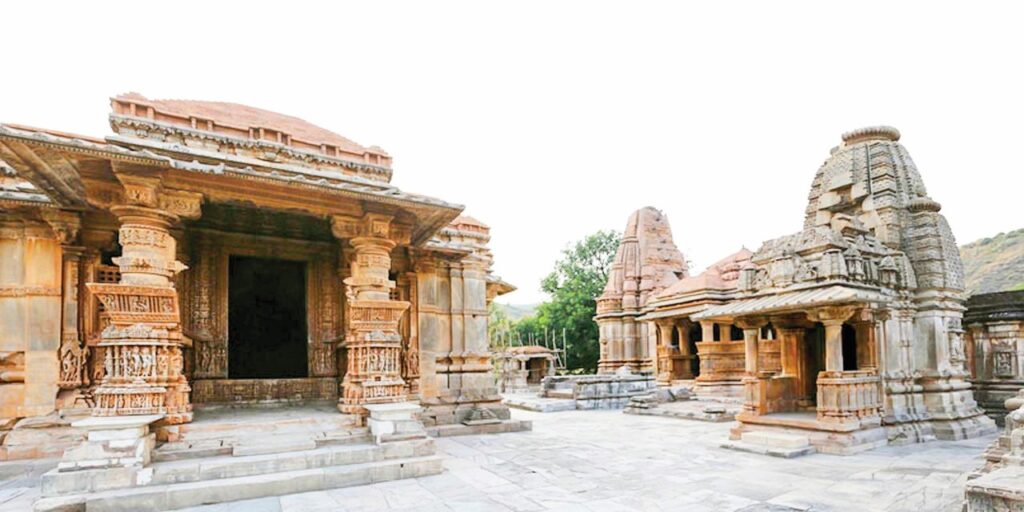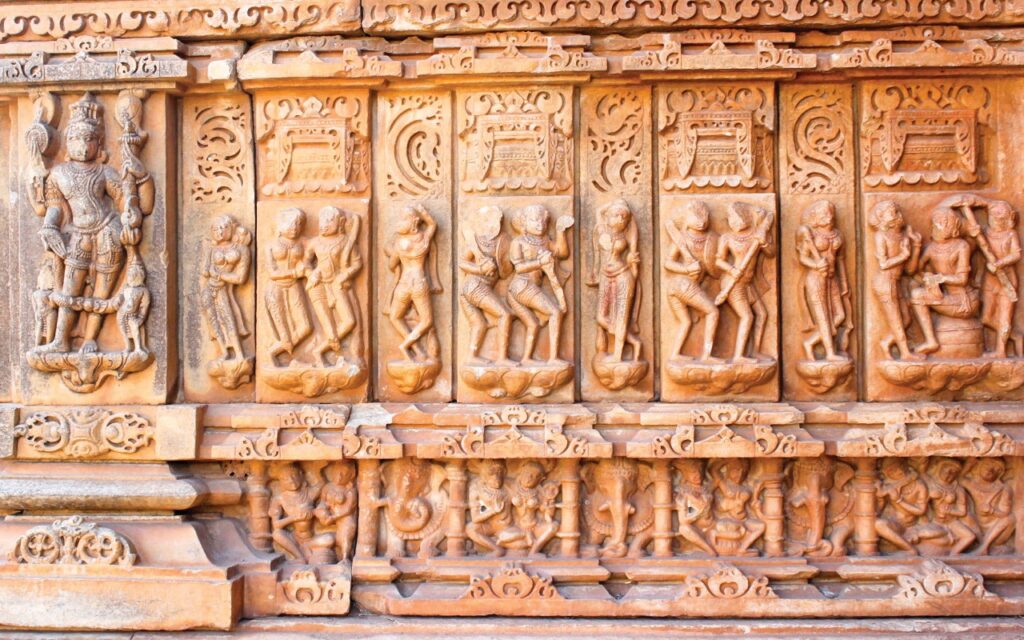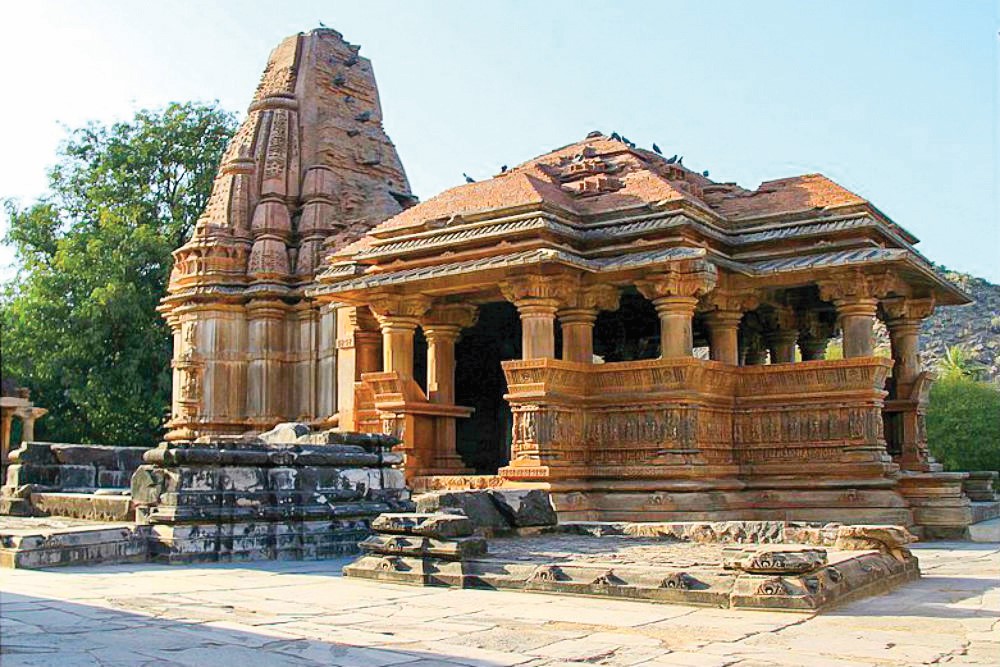The twin temples of Nagda are 1,000 year old old temples that are a combination of divine architecture and domestic legend. Behind their naming reveals a fascinating linguistic journey. Over centuries, “Sahasra-Bahu,” an epithet of Lord Vishnu, transformed into the more colloquial “Sas-Bahu,” giving these architectural masterpieces an unexpectedly domestic twist.
Royal Devotion in Stone
“These temples embody a unique story of faith and family,” explains Rajendra, a local historian who has spent decades studying the complex. According to him, King Mahipal of the Kachchhwaha dynasty commissioned them in the 10th century, the larger shrine for his queen, a devoted Vishnu worshipper, and later, a smaller one for his daughter in law, who followed Shaivite traditions.
Standing just 23 kilometers from Udaipur’s main streets, these twin temples share a platform facing an ancient temple tank, their spires reaching skyward in harmony. The larger temple, flanked by ten subsidiary shrines (some now reduced to their foundations), commands attention with its soaring architecture. Its smaller part, surrounded by four subsidiary shrines, matches its grandeur in artistry if not in scale.
Architectural time capsule
They showcase early elements of the Māru Gurjara style that would later define Rajasthani architecture while maintaining distinctive features that mark them as unique.
The temple’s exterior presents an intriguing contrast; relatively austere walls give way to elaborately carved entrances and porches. Step inside, however, and the true magic reveals itself. Ceilings and walls come alive with intricate carvings, celestial dancers frozen in mid movement, deities locked in eternal conversation, and geometric patterns that seem to shift in the changing light.

Standing tall through centuries
Time has left its mark on these ancient stones. The smaller temple’s shikhara (spire) has been restored to its former glory, while the larger one remains truncated, bearing silent witness to historical turbulence. Below the main platform, a torana style entrance screen creates a striking first impression with its four columns and decorative cusped arch.
“Look up,” Singh says, pointing to faint drawings of lotus flowers on the ceiling. “These survived even after Sultan Iltutmish’s forces attacked Nagda in 1226.” Such elements provide intriguing views into the temples’ earlier glory, when Nagda served as the seat of the powerful Mewar empire.
Sacred Geography
The complex’s environment increases its spiritual importance. The temples face a holy tank, and their reflections dance on the water during the monsoon season. Nearby, the Adbhutji Shanthinath Jain Temple reflects the region’s religious diversity, resulting in a sacred setting that transcends specific faiths.

Practical Pilgrim’s Guide
Modern travelers will find these temples remarkably accessible. Located just 20 kilometers from Udaipur’s city center, they’re easily combined with visits to other significant sites. The revered Eklingji temple lies a mere 2.7 kilometers away, while the vibrant temple town of Nathdwara can be reached within 30 kilometers.
The best time to visit is during early morning or late afternoon, when the sun’s angle creates dramatic shadows across the carved surfaces and temperatures remain moderate. The site, under Archaeological Survey of India protection, provides a peaceful alternative to Udaipur’s more crowded attractions.
Living Heritage
Today, these temples serve multiple roles in the community. They remain active places of worship, particularly during festivals, while simultaneously attracting architecture enthusiasts, photographers, and history buffs fascinated by their artistic and cultural significance.
The temples’ survival through centuries of warfare, natural weathering, and changing religious practices speaks to their enduring importance. Under the Archaeological Survey of India’s protection, these remarkable structures continue inspiring new generations while preserving ancient traditions.
Essential Visitor Information
Plan at least two hours to explore the complex thoroughly. The site welcomes visitors from sunrise to sunset for a nominal entry fee. While guides can enrich your understanding, the serene atmosphere also rewards solitary exploration. Photography is permitted, though visitors should respect the temples’ sacred nature. Combine your visit with stops at nearby attractions. Eklingji’s Shiva temple complex offers architectural contrasts, while Nathdwara provides insights into living Krishna worship traditions. Local transport options abound, from taxis to traditional autorickshaws, making the journey part of the adventure.
Essential Travel Tips
– Best visiting hours: 6:00 AM-6:00 PM; the recommended time is 2-3 hours; the distance from Udaipur is 23 km. The nearby attractions would be Eklingji Temple (2.7 km) and Nathdwara (30 km). As for the entry, it has a nominal fee, and the best season to visit is October to March.
Hidden artistic elements
The mandapa (prayer hall) ceilings reveal an encyclopedia of Hindu mythology carved in stone. Here you’ll find scenes from the Ramayana and Mahabharata, along with intricate geometric patterns that demonstrate advanced mathematical understanding.
The temple’s bracket sculptures, which depict sophisticated divine nymphs and musicians who appear to defy the stone’s rigidity, are particularly outstanding. Their flowing stances and exquisite adornments reflect the exceptional ability of 10th-century craftspeople. Look attentively at the pillars, and you’ll see small scenarios from medieval Mewar, merchants selling their products, musicians playing, and devotees praying.
Festivals and Celebrations
While the temples maintain a serene atmosphere most days, they burst into life during traditional festivals. The complex sees particular activity during Maha Shivratri and Janmashtami, when local devotees gather to continue centuries old traditions.
Local Impact and Tourism
The temples’ growing popularity has brought both opportunities and challenges to Nagda village. Local initiatives now train young residents as heritage guides, while traditional craftspeople find new markets for their work among visitors interested in the region’s artistic traditions.
Small shops near the complex offer local handicrafts and refreshments, their owners sharing stories passed down through generations about the temples’ history. The locals believe that these temples are not just their heritage; rather, they’re their identity and livelihood.
Modern Cultural Significance
The temples continue to inspire contemporary artists and architects. Several modern buildings in Rajasthan reference their unique architectural elements, while artists frequently visit to sketch and photograph their intricate details.
Recent digital documentation projects have created detailed 3D scans of the temples, ensuring that future generations can study and appreciate their architectural complexity even as time inevitably takes its toll on the physical structures.
Timeless Appeal
As evening approaches and the sun paints the ancient stones in golden hues, it’s easy to imagine these temples in their heyday, priests chanting sacred verses, oil lamps flickering in deepening twilight, devotees bringing offerings to their chosen deities. The Sahasra Bahu temples reflect more than just architectural marvels or religious devotion. They commemorate a period when art, faith, and family came together to create something spectacular. In today’s fast paced world, these twin temples provide a moment of reflection, an opportunity to connect with the creative and spiritual goals of those who came before us.
For travelers seeking authenticity beyond tourist hotspots, these temples deliver a perfect blend of historical significance, architectural beauty, and spiritual atmosphere. They remind us that sometimes the most meaningful discoveries lie just off the beaten path, waiting for those willing to explore the heart of India’s rich cultural heritage.






